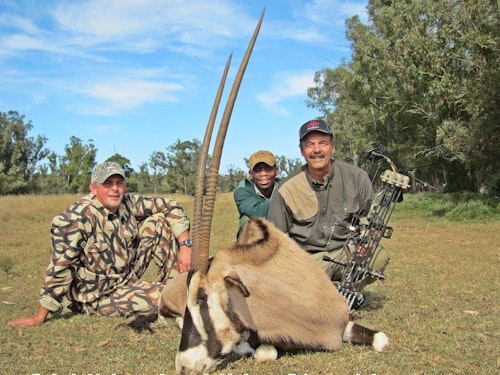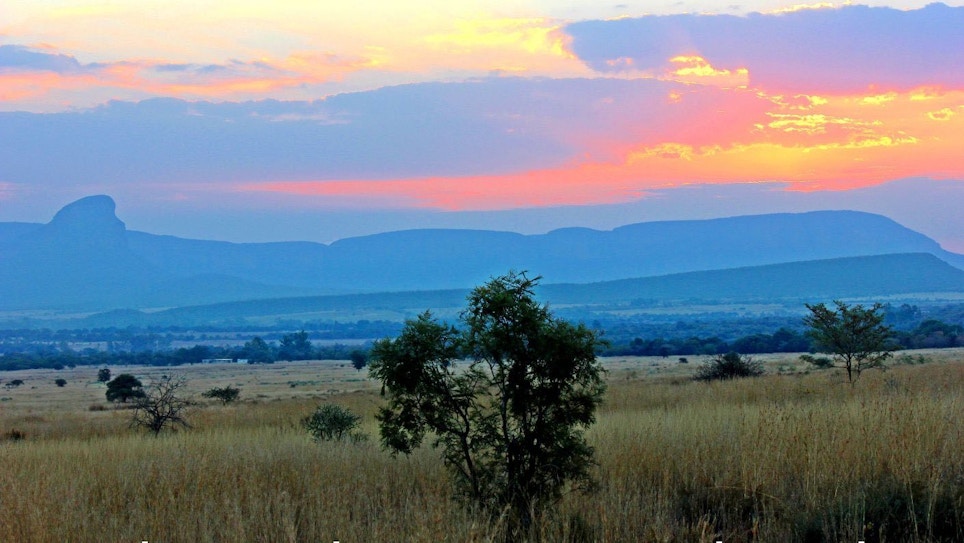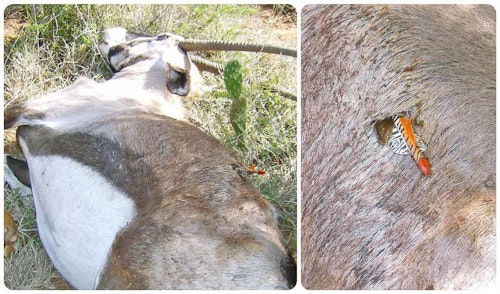“What will you be hunting?” asked friend and outdoors photojournalist extraordinaire Ron Spomer while discussing my upcoming trip to South Africa. Top priorities would be taking zebra, bushbuck and impala with a bow I explained, and each of four springbok color phases with a new Knight muzzleloader, all “walk and stalk” as they say.
Ron replied, “You just love to challenge yourself, don’t you?” Well, true! Challenge is the main reason I started bowhunting. I quickly learned that success is directly related to opportunity, and where on Earth is there more opportunity for bowhunters than southern Africa? Although unsuccessful with zebra, I arrowed a stunning bushbuck on a verdant hillside overlooking the Indian Ocean in Eastern Cape Province the first week of the trip, and a bonus gemsbok as well. Accomplishing the unofficial “Springbok Slam” the following week in Northern Cape Province was another memorable highlight. This, however, is a tale of two impalas.

Passing opportunities to take young impalas the first week, our plan called for hunting them the last few days of the trip near Sterkrivier, in the Province of Limpopo with NB Safaris. Owner Neil Barnard operates a beautiful traditional hunting camp, situated on a spectacular piece of bushveld savannah and woodland, near the magnificent Waterberg Mountains. This area is loaded with plains game, including impalas — BIG impalas.
Easy, Right? Wrong
The last leg of this Africa adventure began soon after arrival at the lodge. PH Koos Nel knew the expansive property well, and it didn’t take long for us to locate a bachelor herd of four impala rams feeding on a wooded hillside. Two of them would exceed the 24-inch benchmark, signifying trophy quality. With my muzzleloader and its proven 200+ yard performance for backup if no archery opportunities presented, I thought, This is going to be easy! That thought was short-lived.
As the impalas moved down the slope toward kudu feeding below, a startling sound of crashing metal reverberated for several seconds. What the . . . ? Apparently, impala activity spooked the kudu, which then vanished along with our quarry. Although we tracked and searched the woodland for the remainder of the afternoon, we were unable to relocate the band of big rams. So much for “easy.”
After a few close calls during previous days, dawn arrived on our last morning of hunting, with no impalas in the salt. We were greeted at daybreak by a troop of baboons with young male sentries screaming — amazingly big sounds from such small animals. It wasn’t long before Elias spotted two mature impala rams moving through the woodland. During the next three hours I traded bow for muzzleloader and muzzleloader for bow several times, but could not close the deal. We sneaked within range several times, but thick bush obstructed clear shooting. Later we caught the larger ram passing through an opening, but he continued moving without offering a shot, despite a variety of sounds made by both Koos and Elias trying to stop him.
In disbelief, Koos said: “That old ram must be deaf!” A kudu cow sounded off, foiling another attempt. After each failure, Elias located the tracks and we followed. It was truly a pleasure observing a master practicing his craft first hand. After miles of chasing, Elias again spotted the old ram. We slipped into position for a shot through a small window in the bush. Beyond bow range, Koos set his sticks for the muzzleloader. The firearm belched a cloud of smoke, and the grand old ram dropped in his tracks. I finally tagged a heavy-horned impala 13 days into my Africa hunt.

Stalking With Stick and String
With little time left, taking an impala with my bow remained as top priority. Thus, we set out on the final afternoon to find another impala — an animal acknowledged among the most difficult to take with a bow. Impala wariness and quickness is legendary, and I heard many remarkable stories about them. One claimed that it’s impossible to win a staring match with impalas, and I personally validated this one the previous week. Caught crawling by a mature ewe, she huffed and puffed and stomped her foot, but never even blinked during our 15-minute standoff, which ended when I gave up.
Another often repeated story claimed that impalas are frequently hit on their opposite side by bowhunters, as they are quick enough to turn 180 degrees before the arrow arrives, even when shot from inside 30 yards. Eastern Cape outfitter, PH and bowhunter Russ Lovemore, verified this one from his own experience. Talk about jumping the string.
That afternoon Koos’ personal tracker Elias produced once again, spotting a likely subject leaving a waterhole. We closed distance quickly, and my first glimpse of the beautiful ram came from just 77 yards. There was little to shield my approach through sparse 18-inch-tall grass, but the feeding ram’s position was elevated from mine and the wind was favorable.
Picking a distant bush that would provide cover for a shot, I nocked a fast lightweight arrow and crawled away. The stalk went well, but the ram was moving while grazing, so I had to reposition. Fifteen feet beyond the bush, the ram suddenly appeared above, facing me head-on with that now familiar impala stare.
Caught in an incredibly awkward half-squatting half-crawling position, my left leg was forward, right leg back and left arm extended with bow in hand. Only the brim of my cap shielded my bare face from late afternoon sun — my mask was forgotten in the camp laundry. With nose buried deep in the grass, I prepared for the standoff to follow. It didn’t take long to realize that mental stamina would be more important than physical.
Within minutes, nearly every muscle in my 60-year-old body was near cramping, but I was determined to win. As time passed, mind games began. My body screamed, Give it up! but willpower prevented surrender. With grass pressed in my face, binocular vision was lost, and there appeared to be two impalas — but there was really only one — or were there now two? What seemed like an hour of physical torture and mental anguish actually lasted about 15 minutes, according to Koos’ watch.
Nearing my endurance limit, I took a chance and peeked. The ram was gone. I relaxed for an instant before carefully moving up just enough to spot him feeding again, head down and quartering away. Rolling to my knees to gain elevation for clearance, I guess-timated the distance was 30 yards while drawing as slowly and quietly as possible. Settling my sight pin just behind the front shoulder where fawn color meets a rusty hue, the ram suddenly turned broadside and cast that intense gaze on my steadying form. A small sighting adjustment and the arrow was on its way.

The release and line were perfect, but the impact sound was not the solid “thwack” I expected. Suspicion that my lightweight, 372-grain Gold Tip arrow hit high was supported by a closer-than-expected shot distance of only 22 yards, and careful inspection of the blood-coated arrow. I suggested that we give the animal some time. But with less than 90 minutes of daylight remaining, and the woodland loaded with nocturnal predators such as hyena, jackal, caracal and leopard, Koos insisted, “We must follow-up quickly before we lose light.”
The discerning PH took my bow, handed me the muzzleloader and advised, “Be ready to shoot.” Elias set out on the trail, Koos followed closely with me right behind. We tracked through a natural cut in the thornbush to the edge of a grassy veld, turning up the shaded side of the brush line. Suddenly there was movement ahead, as the bedded ram lifted his head just 60 yards away. Koos hissed, “Shoot!” But considering 6-7 feet of blackpowder ignition flame, to do so from third position was unsafe and completely out of the question. With adrenaline flowing, the wounded ram sprinted into the tall grass, and despite the best tracking efforts of Elias and Koos, he was lost.
What should have been one of my best days hunting had quickly turned into bitter disappointment. A poor shot and thoughts of losing my first big game animal in 50-plus years of hunting were making me sick. The feeling continued throughout the night and the next morning, as we departed on the 10,000 mile journey home.
But this “tale of two impalas” has a happy ending. On arrival back home, an email from NB Safaris related that my impala ram had been recovered. Yes!
“Dankie vir die wonderlike ervaring” to Neil Barnard and the staff at NB Safaris, and “dankie dat jy so baie vir jou pogings” to my new South African comrades Koos Nel and Elias, who found my lost impala shortly after we departed and thus, brought both fruition and closure to this memorable chapter of life experience.
Sidebar: Arrows, Broadheads and Bows
African outfitters prefer heavy arrows for penetration, and fixed-blade broadheads for reliability and toughness, particularly when hunting large-bodied, heavy-boned grass eaters such as zebra, wildebeest and gemsbok. Smaller, lightning-fast animals like impala and bushbuck also ranked high on my priority list, and notorious string jumpers like the tiny duikers would be ever-present targets of opportunity. My hunting method would be “walk and stalk” — no sitting — so I chose my old reliable 60-pound PSE X-Force bow over my 70-pound EVO Max for drawing/holding ease in awkward positions that often result when crawling around in the bush.
During his annual U.S. tour, Safari Trails International owner/outfitter Russ Lovemore and I visited PSE in Tucson, Arizona. Impressed with penetration of their Carbon Force Black Mamba arrows, we selected and prepped some of the 400-spine 9.2 grains per inch shafts for my hunt. These were fitted with 10.5 grains per inch weighted tubes and stainless-steel inserts and collars, for added FOC weight and durability. With 100-grain G5 Montec broadheads, finished arrows weighed 705-grains. Flying at just 220 fps but generating 75 ft-lbs. of energy and a whopping 0.685 slugs of momentum, these arrows delivered remarkably quick kills.
Believing that I also needed faster arrows for smaller flighty game, I prepared some 400-spine Gold Tip Hunter XT arrows. At 372-grains including 100-grain Ramcat broadheads, these flew nearly 100 fps faster than the Black Mambas. Tuning my bow to shoot both arrows efficiently was difficult, and I had to memorize 10 different impact distances — two for each of five TruGlo sight pins. Two “ducking” duikers evaded these blazing-fast arrows despite near perfect placement. Comparative arrow noise in flight was considerably greater, so faster is not always better. All considered, I don’t recommend carrying two different weight arrows while hunting.
Sidebar: Tips for Hunting Africa
- Outfitter Selection: There can be significant differences between outfitters that take bowhunters, and bowhunting outfitters. Both will typically have blinds, elevated or in-ground, positioned on waterholes. The latter however, will be more accommodating if you prefer “walk and stalk” hunting over sitting all day, use traditional equipment, or are looking to hunt a particular animal.
- Take Two Bows: Delayed or damaged rifles are easily replaced with loaners or rentals, but it’s difficult to hunt with a replacement bow. If you have two bows, invest in a top-notch two-bow case and take both.
- Air Travel: Be sure to allow ample time between connecting flights for inevitable delays. You might make a tight connection, but your luggage may not, causing lost hunting time. Delta and South African Airways offer non-stop red-eye flights to destinations in southern Africa, and these are my favorites. Arriving refreshed after sleeping on the flight avoids losing a day to jet lag.
- Travel Documentation: Current passport with at least six blank pages, letter of invitation from your outfitter and printed travel itinerary are minimum requirements. Proof of ownership (U.S. Customs Form 4457) for bows and expensive gear such binoculars, rangefinders and cameras taken abroad is recommended.
- Checked Baggage: Use TSA approved locks on your bow case, as well as your luggage, to avoid breakage, because TSA agents will open each and every piece multiple times during your travels. If they cannot easily open your lock, they will cut it or break it.
- Tipping: It’s customary to tip guides/PH, trackers, skinners and camp staff. Policy varies widely, so it’s best to inquire in advance. Some outfitters don’t want their staff tipped directly, preferring to collect tips for later distribution, and in some camps the staff will quietly solicit tips from you individually. I usually exchange a few hundred dollars for local currency and place appropriate amounts in envelopes to avoid fumbling with cash in front of staff assembled to bid you farewell on departure.
- Surprise Costs: Despite best efforts to identify all costs for hunting abroad, there always seem to be surprises. Fees for exporting, and then importing horns, skulls, capes and back skins can be egregious, so it pays to check in advance. Insurance is often more than airfreight, and these account for only half the export bill, which is typically padded with a variety of surcharges and fees. Import bills include various handling fees and customs duty. Together, these costs should average about $175 per animal for plains game.
Photos by Tony Martins








